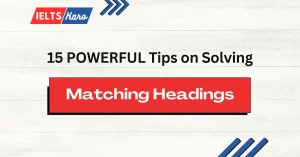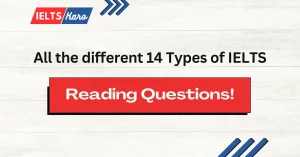Introduction to True False Not Given Tips
The True/False/Not Given question format is one of the most confusing types of questions for IELTS Reading.
It requires you to scrutinise statements and determine their accuracy based on the information provided in the passage. In this blog, we will discuss in detail the True False Not Given tips so that you can achieve a high band score in your IELTS exam.
You can also practice IELTS Reading True False Not Given Lessons.
You can find them in IELTS General Training and Academic versions. But before proceeding to attempt them, you need to understand what makes a question TRUE, FALSE or NOT GIVEN.
What is the IELTS Reading True False Not Given Questions?
True False Not Given questions require you to determine if the information in a statement is true, false, or not given based on the passage provided. Understanding the differences between these options is crucial for success.
- True: You are able to find this information in the passage, and it perfectly agrees with the statement.
- False: You are able to find completely contrary information in the passage that does not align with the statement.
Not Given: Either the passage does NOT contain the information, OR You CANNOT find complete information about the statement.
Importance of the True False Not Given Section
This question type assesses a range of critical reading abilities:
- Precision: The capacity to focus on details within the text.
- Inference: The skill to deduce information that is implied but not explicitly stated.
- Paraphrasing: The ability to recognize ideas expressed in different linguistic forms.
- Time Management: The efficiency to locate relevant information rapidly.
How to Approach True False Not Given Questions
- Grasp the Instructions: Ensure a clear comprehension of the task requirements.
- Identify Key Terms: Pinpoint crucial words or phrases within the statements to guide your search within the passage.
- Cross-Reference: Carefully compare the statement to the corresponding section of the text.
- Recognize Paraphrasing: Be attuned to synonyms and rephrased ideas.
- Beware of Qualifiers: Pay close attention to words like “all,” “some,” “most,” and “always,” as they can significantly alter the meaning of a statement.
- Process of Elimination: If uncertainty arises, eliminate improbable options to increase your chances of selecting the correct answer.
Example Questions and Explanations
Passage:
Paragraph 1: Chocolate, derived from the cocoa bean, has a rich history spanning centuries. Originating in the Americas, it was revered by ancient civilizations for its medicinal properties.
Paragraph 2: The process of chocolate production involves several stages, from harvesting the cocoa beans to roasting, grinding, and tempering the chocolate. Today, chocolate is enjoyed globally in various forms.
Questions:
- Cocoa beans were initially cultivated in Europe.
- The production of chocolate has a number of processes.
- Cocoa has been known to heal all types of skin ailments.
Answers and Explanations:
- False: The passage explicitly states that chocolate originated in the Americas.
- True: The passage outlines multiple stages involved in chocolate production, indicating a complex process.
- Not Given: While it is true that the passage mentioned about its medicinal properties, did it REALLY talk about curing skin ailments and diseases? Since there is no information on it, this is Not Given.
IELTS Reading True False Not Given Tips for Success
Here are some tips for the IELTS True/False/Not Given Reading section:
1. Invest some time in trying to analyse, understand the statement and align it with the question.
You should read the statement carefully and make sure you understand it before you start looking for the answer in the passage. This will help you to avoid making mistakes.
2. The biggest trap in IELTS is the usage of synonyms, i.e. rewording. Keep an eye out for similar words to make sure that you understand the meaning.
The words used in the statement may not be the same as the words used in the passage. You need to be able to recognise different ways of saying the same thing. For example, change means to alter. Similarly, unsafe means hazardous or dangerous.
3. Only matching keywords won’t take you anywhere. Focus on matching the actual meaning of the words.
You should not just look for the same words in the passage. You need to make sure that the meaning of the statement is the same as the meaning of the passage.
4. FALSE or NO means that the information is there but completely contradicts or is opposite to what it mentioned in the passage.
If the statement is false, it will say the opposite of what is in the passage.
5. Not Given means that either there is no information, or half info on that keyword.
This means that if the statement is not given, it will not be mentioned at all in the passage.
6. Opt for Computer-based so that you can make changes easily.
You can always go back and make changes on your IELTS exam while attempting on a computer.
7. All answers follow a sequential and logical order of the passage. Make sure to follow this step to have as many correct True False Not Given questions as possible.
The answers to the True/False/Not Given questions will be in the same order as the information in the passage. This may not be the case for other types of questions.
- Consistent Practice: Regular engagement with True False Not Given questions enhances your ability to identify key information and understand the nuances of the text.
- Time Management: Simulate exam conditions by practicing under timed constraints using tests only from the IELTS test books.
- Learn from Mistakes: Analyse incorrect responses to pinpoint areas for improvement.
- Expand Vocabulary: Building a robust vocabulary facilitates a deeper comprehension of the text.
- Maintain Focus: Avoid distractions and concentrate on the task at hand.
By adhering to these guidelines and dedicating consistent practice, you can significantly elevate your performance on the IELTS Reading True False Not Given section.
FAQs
1. What is the difference between True, False, and Not Given?
True means the statement matches the information in the passage. False means the statement contradicts the information. Not Given means the information is not mentioned in the passage.
2. How can I improve my accuracy with these questions?
Practice regularly, pay attention to qualifiers, and differentiate between facts and opinions to improve accuracy
3. Are there specific topics that frequently appear with these questions?
True False Not Given questions can appear with any topic, so it’s essential to practice with a variety of passages.
4. How important is time management for these questions?
Time management is crucial. Practice with timed sessions to enhance your speed and accuracy.
5. Can True False Not Given questions appear in all sections of the test?
Yes, these questions can appear in various sections of reading comprehension tests like IELTS and TOEFL.





